Exchange of polar lipids from adults to neonates in Daphnia magna: Perturbations in sphingomyelin allocation by dietary lipids and environmental toxicants
- PMID: 28542405
- PMCID: PMC5443554
- DOI: 10.1371/journal.pone.0178131
Exchange of polar lipids from adults to neonates in Daphnia magna: Perturbations in sphingomyelin allocation by dietary lipids and environmental toxicants
Abstract
Because xenosensing nuclear receptors are also lipid sensors that regulate lipid allocation, we hypothesized that toxicant-induced modulation of HR96 activity would alter lipid profiles and the balance between adult survival and neonate production following exposure in Daphnia magna. Adult daphnids were exposed to unsaturated fatty acid- and toxicant- activators or inhibitors of HR96 and later starved to test whether chemical exposure altered allocation toward survival or reproduction. The HR96 activators, linoleic acid and atrazine, decreased reproduction as expected with concomitant changes in the expression of HR96 regulated genes such as magro. The HR96 inhibitors, docosahexaenoic acid (DHA) and triclosan, increased reproduction or neonate starvation survival, respectively. However, pre-exposure to triclosan increased in neonate survival at the expense of reproductive maturation. Lipidomic analysis revealed that sphingomyelins (SM) are predominantly found in neonates and therefore we propose are important in development. DHA and triclosan increased neonatal SM, consistent with HR96's regulation of Niemann-Pick genes. While DHA altered expression of magro, Niemann-Pick 1b, mannosidase, and other HR96-regulated genes as expected, triclosan primarily perturbed sphingomyelinase and mannosidase expression indicating different but potentially overlapping mechanisms for perturbing SM. Overall, SM appears to be a key lipid in Daphnia maturation and further support was provided by carmofur, which inhibits sphingomyelin/ceramide metabolism and in turn severely represses Daphnia maturation and initial brood production. In conclusion, toxicants can perturb lipid allocation and in turn impair development and reproduction.
Conflict of interest statement
Figures


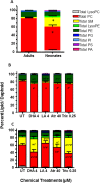
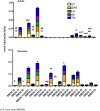
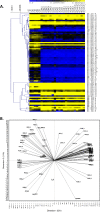


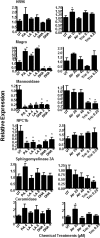
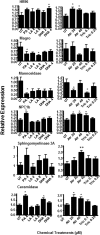

Similar articles
-
Perturbations in polar lipids, starvation survival and reproduction following exposure to unsaturated fatty acids or environmental toxicants in Daphnia magna.Chemosphere. 2016 Feb;144:2302-11. doi: 10.1016/j.chemosphere.2015.11.015. Epub 2015 Nov 21. Chemosphere. 2016. PMID: 26606184 Free PMC article.
-
The HR96 activator, atrazine, reduces sensitivity of D. magna to triclosan and DHA.Chemosphere. 2015 Jun;128:299-306. doi: 10.1016/j.chemosphere.2015.02.027. Epub 2015 Mar 3. Chemosphere. 2015. PMID: 25747156 Free PMC article.
-
Daphnia HR96 is a promiscuous xenobiotic and endobiotic nuclear receptor.Aquat Toxicol. 2012 Jul 15;116-117:69-78. doi: 10.1016/j.aquatox.2012.03.005. Epub 2012 Mar 15. Aquat Toxicol. 2012. PMID: 22466357 Free PMC article.
-
RNA sequencing indicates that atrazine induces multiple detoxification genes in Daphnia magna and this is a potential source of its mixture interactions with other chemicals.Chemosphere. 2017 Dec;189:699-708. doi: 10.1016/j.chemosphere.2017.09.107. Epub 2017 Sep 25. Chemosphere. 2017. PMID: 28968576 Free PMC article.
-
The potential of dietary polyunsaturated fatty acids to modulate eicosanoid synthesis and reproduction in Daphnia magna: a gene expression approach.Comp Biochem Physiol A Mol Integr Physiol. 2012 Aug;162(4):449-54. doi: 10.1016/j.cbpa.2012.05.004. Epub 2012 May 4. Comp Biochem Physiol A Mol Integr Physiol. 2012. PMID: 22564377
Cited by
-
The toxicity assessment of phosmet on development, reproduction, and gene expression in Daphnia magna.PeerJ. 2024 Feb 28;12:e17034. doi: 10.7717/peerj.17034. eCollection 2024. PeerJ. 2024. PMID: 38436013 Free PMC article.
-
Triclosan leads to dysregulation of the metabolic regulator FGF21 exacerbating high fat diet-induced nonalcoholic fatty liver disease.Proc Natl Acad Sci U S A. 2020 Dec 8;117(49):31259-31266. doi: 10.1073/pnas.2017129117. Epub 2020 Nov 23. Proc Natl Acad Sci U S A. 2020. PMID: 33229553 Free PMC article.
-
The reproductive effects of the cancer chemotherapy agent, Carmofur, on Daphnia magna are mediated by its metabolite, 5-Fluorouracil.Ecotoxicology. 2022 Jul;31(5):860-872. doi: 10.1007/s10646-022-02551-5. Epub 2022 May 17. Ecotoxicology. 2022. PMID: 35579761 Free PMC article.
-
Multidrug Resistance Like Protein 1 Activity in Malpighian Tubules Regulates Lipid Homeostasis in Drosophila.Membranes (Basel). 2021 Jun 8;11(6):432. doi: 10.3390/membranes11060432. Membranes (Basel). 2021. PMID: 34201304 Free PMC article.
-
In-Vivo NMR Spectroscopy: A Powerful and Complimentary Tool for Understanding Environmental Toxicity.Metabolites. 2018 May 24;8(2):35. doi: 10.3390/metabo8020035. Metabolites. 2018. PMID: 29795000 Free PMC article. Review.
References
-
- Hartwich M, Martin-Creuzburg D, Rothhaupt D, Wacker A. Oligotrophication of the large, deep lake alters food quantity and quality constraints at the primary producer-consumer interface. Oikos. 2012;121:1702–12.
-
- Brown MR, Jeffrey SW, Volkman JK, Dunstan GA. Nutritional properties of microalgae for mariculture. Aquaculture. 1997;151:315–31.
-
- Lynn DA, Dalton HM, Sowa JN, Wang MC, Soukas AA, Curran SP. Omega-3 and -6 fatty acids allocate somatic and germline lipids to ensure fitness during nutrient and oxidative stress in Caenorhabditis elegans. Proc Natl Acad Sci USA. 2015;112:15378–83. doi: 10.1073/pnas.1514012112 - DOI - PMC - PubMed
-
- Hulbert AJ, Turner N, Storlien LH, Else PL. Dietary fats and membrane function: implications for metabolism and disease. Biol Rev Camb Philos Soc. 2005;80(1):155–69. - PubMed
MeSH terms
Substances
Grants and funding
LinkOut - more resources
Full Text Sources
Other Literature Sources

